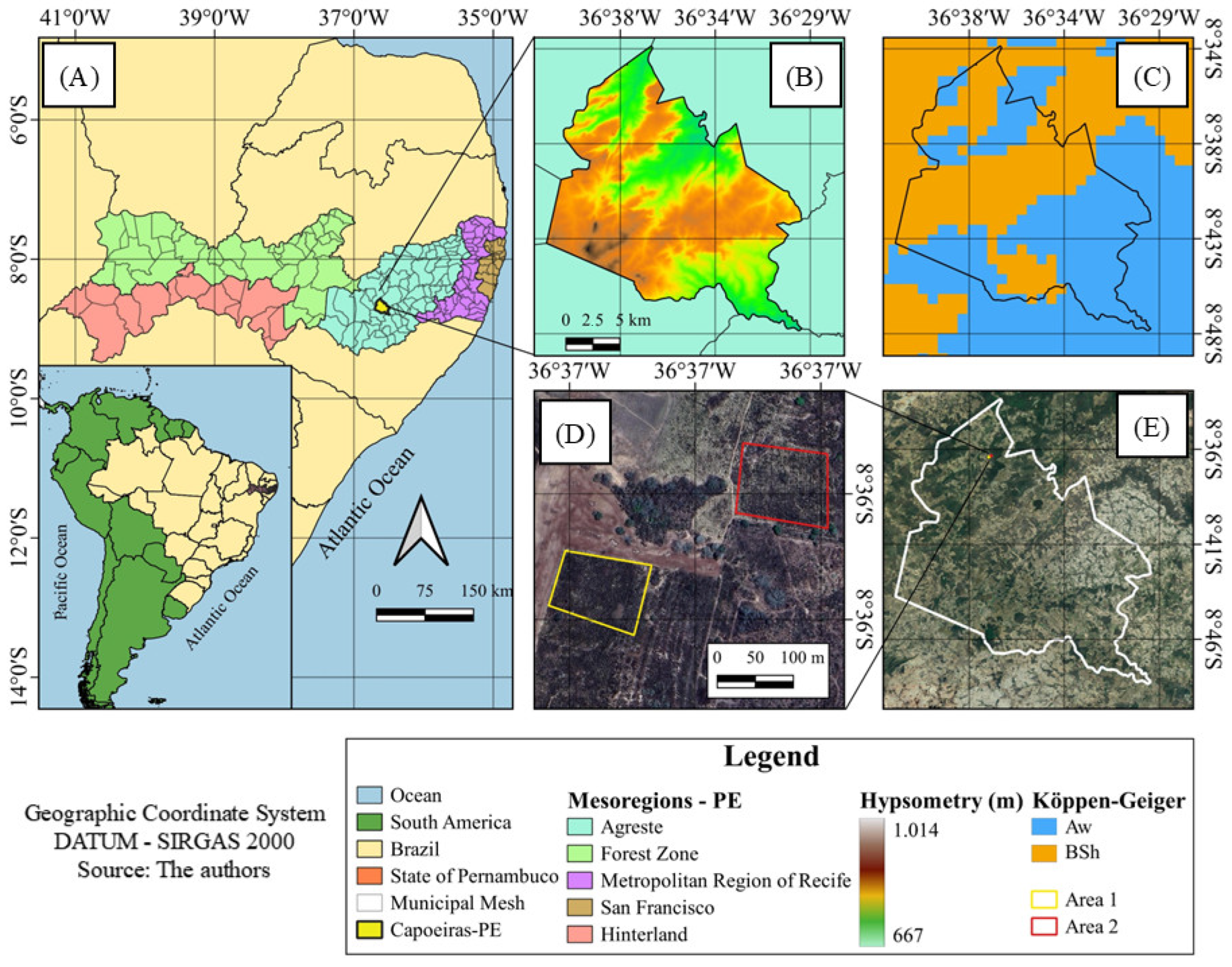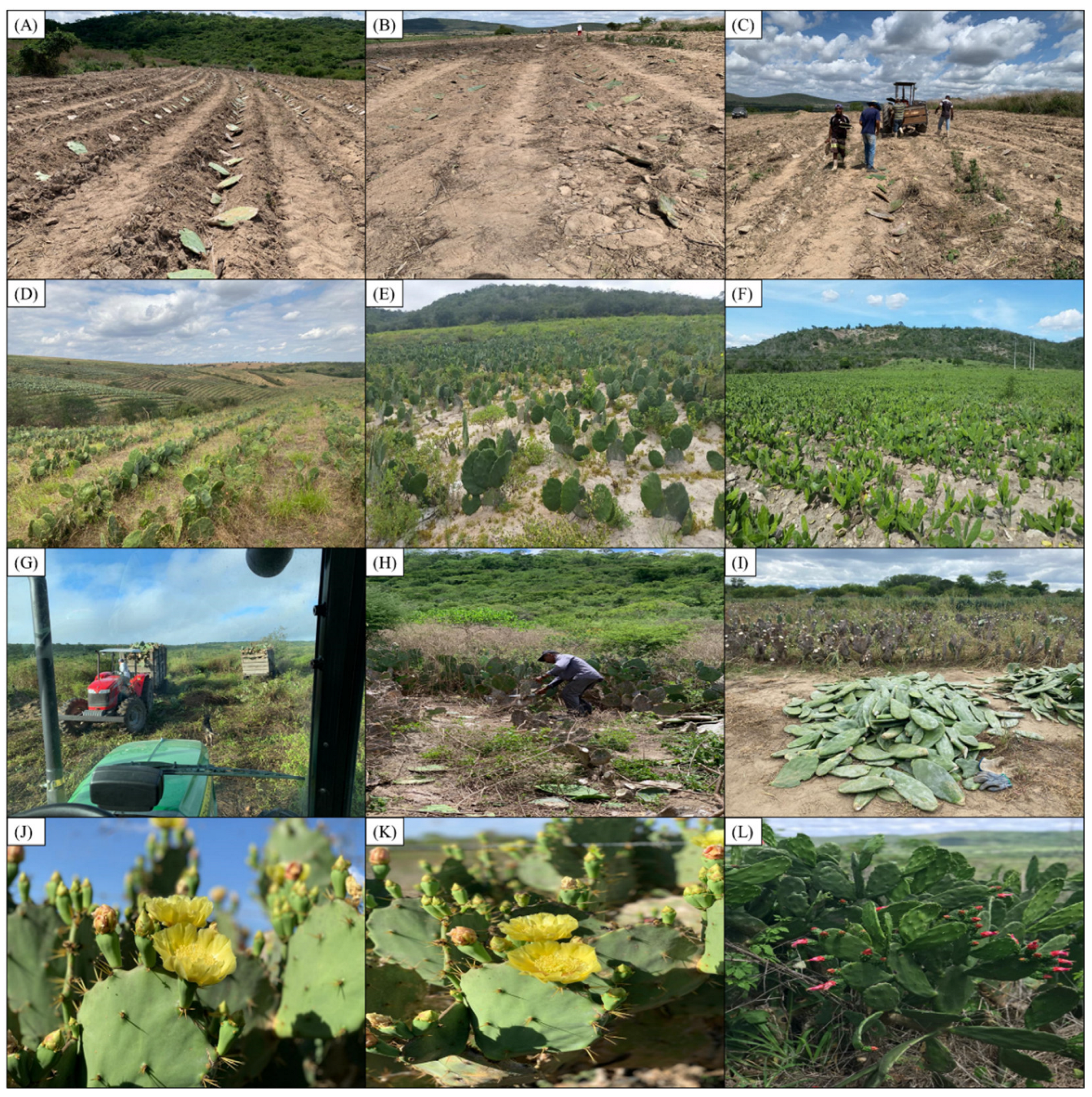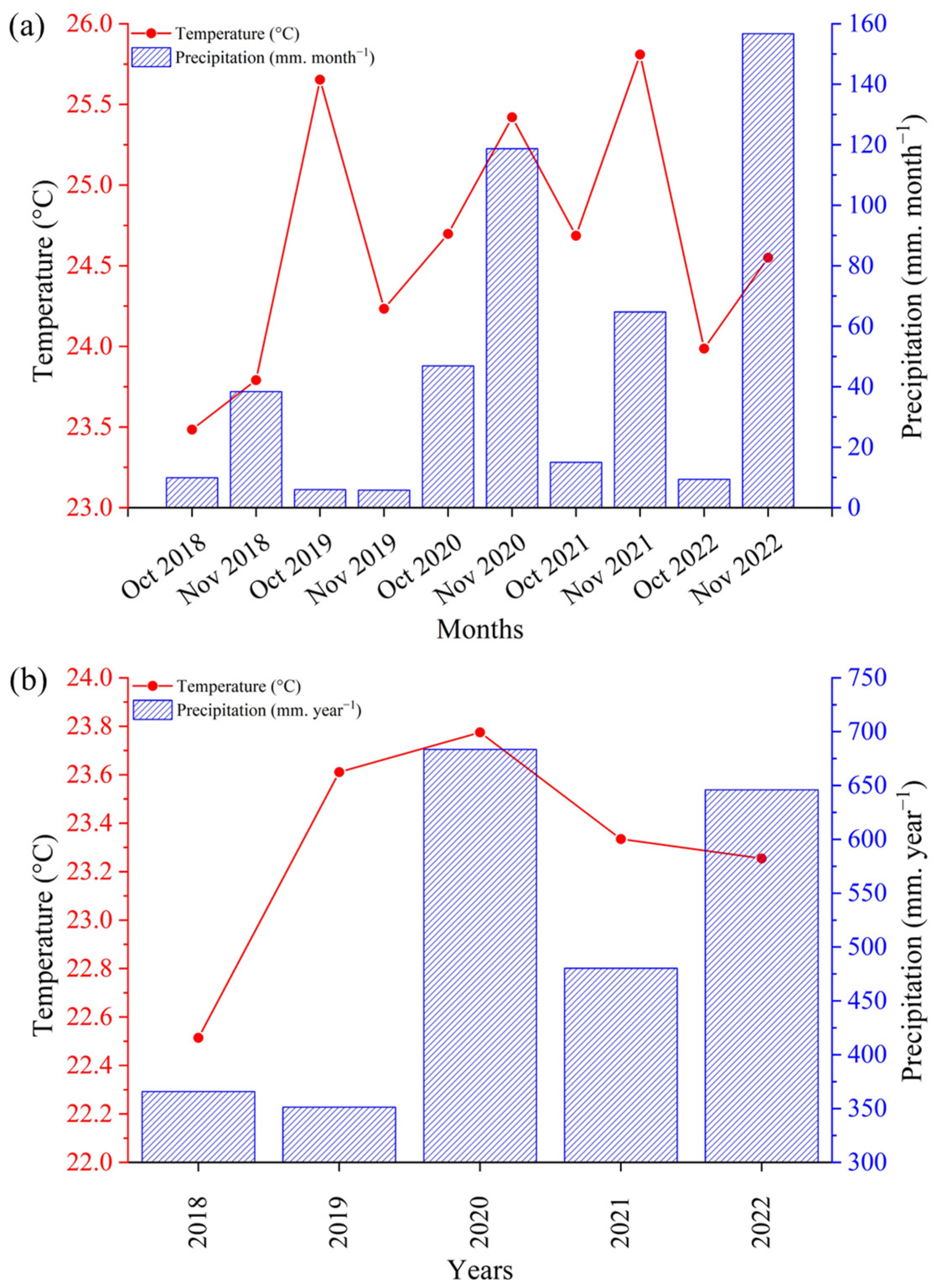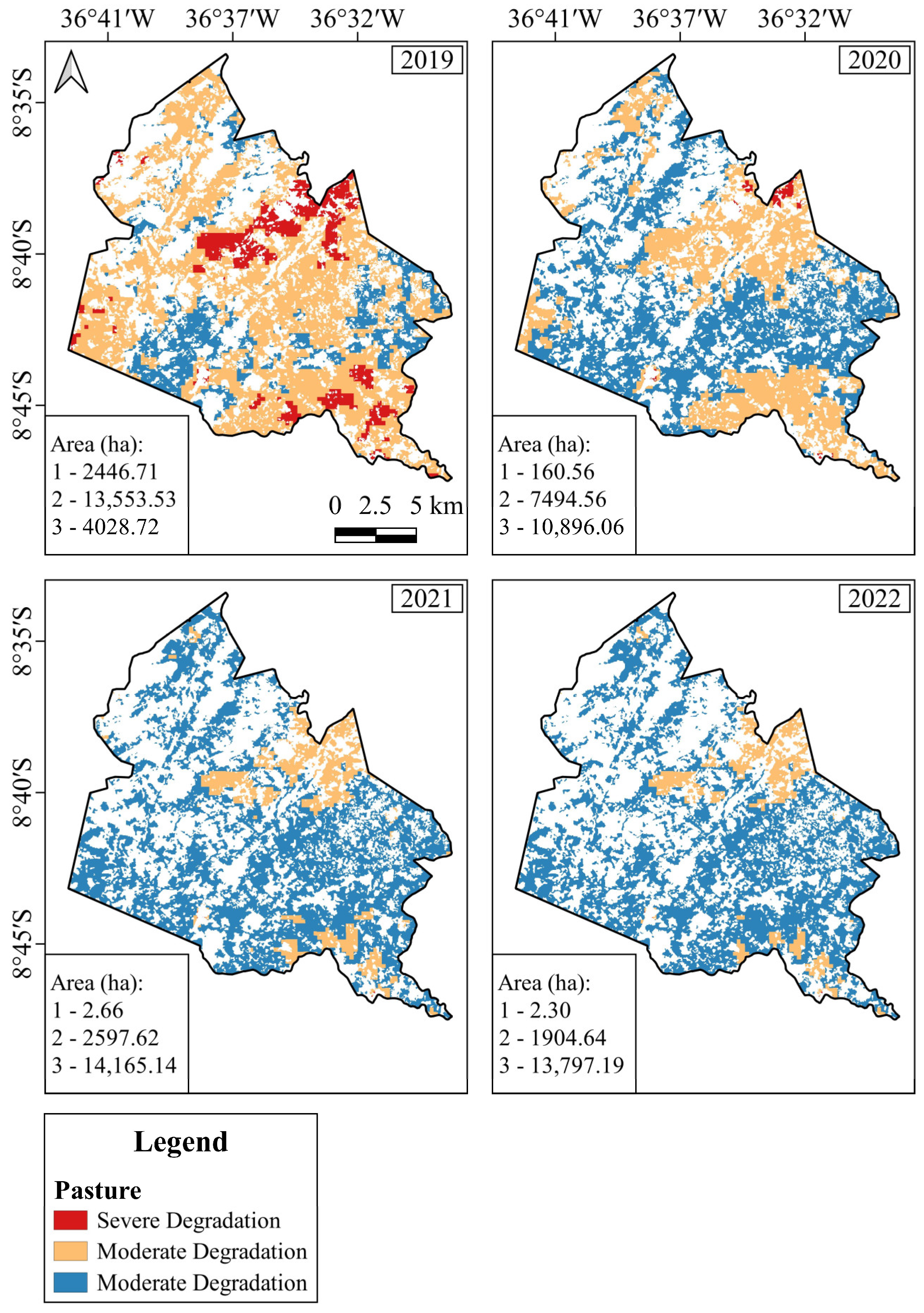Application of Geotechnologies in the Characterization of Forage Palm Production Areas in the Brazilian Semiarid Region
Abstract
1. Introduction
2. Materials and Methods
2.1. Study Area and Characterization of Palm Clones
2.2. Normalized Difference Vegetation Index Processed in Google Earth Engine
2.3. Climate Characterization via the National Meteorological Institute
2.4. Descriptive Statistics
2.5. Land Use and Land Cover Classification via MapBiomas Brazil
2.6. Identification and Measurement of Forage Palm Clone Cultivation Areas
3. Results
3.1. Study Area
3.2. Characterization of Forage Palm Species
3.3. NDVI Descriptive Statistics for “Orelha de Elefante Mexicana” and “Miúda” Palms
3.4. Temperature and Rainfall Data
3.5. NDVI Analysis
3.6. NDVI Reclassification
3.7. Land Use and Occupation (LULC)
3.8. Pasture Degradation
4. Discussion
5. Conclusions
Author Contributions
Funding
Data Availability Statement
Acknowledgments
Conflicts of Interest
References
- Moura, M.M.; dos Santos, A.R.; Pezzopane, J.E.M.; Alexandre, R.S.; da Silva, S.F.; Pimentel, S.M.; de Andrade, M.S.S.; Silva, F.G.R.; Branco, E.R.F.; Moreira, T.R.; et al. Relation of El Niño and La Niña Phenomena to Precipitation, Evapotranspiration and Temperature in the Amazon Basin. Sci. Total Environ. 2019, 651, 1639–1651. [Google Scholar] [CrossRef] [PubMed]
- Silva, A.M.; da Silva, R.M.; Santos, C.A.G. Automated Surface Energy Balance Algorithm for Land (ASEBAL) Based on Automating Endmember Pixel Selection for Evapotranspiration Calculation in MODIS Orbital Images. Int. J. Appl. Earth Obs. Geoinf. 2019, 79, 1–11. [Google Scholar] [CrossRef]
- Barbosa, H.A. Flash Drought and Its Characteristics in Northeastern South America during 2004–2022 Using Satellite-Based Products. Atmosphere 2023, 14, 1629. [Google Scholar] [CrossRef]
- Dantas, J.C.; da Silva, R.M.; Santos, C.A.G. Drought Impacts, Social Organization, and Public Policies in Northeastern Brazil: A Case Study of the Upper Paraíba River Basin. Environ. Monit. Assess. 2020, 192, 317. [Google Scholar] [CrossRef]
- Cirilo, J.A. Políticas Públicas de Recursos Hídricos Para o Semi-Árido. Estud. Avançados 2008, 22, 61–82. [Google Scholar] [CrossRef]
- Dubeux, J.C.B.; Santos, M.V.F.d.; Cunha, M.V.d.; Santos, D.C.d.; Souza, R.T.d.A.; Mello, A.C.L.d.; Souza, T.C.d. Cactus (Opuntia and Nopalea) Nutritive Value: A Review. Anim. Feed. Sci. Technol. 2021, 275, 114890. [Google Scholar] [CrossRef]
- Silva, M.V.d.; Pandorfi, H.; Almeida, G.L.P.d.; Lima, R.P.d.; Santos, A.d.; Jardim, A.M.d.R.F.; Rolim, M.M.; Silva, J.L.B.d.; Batista, P.H.D.; Silva, R.A.B.d.; et al. Spatio-Temporal Monitoring of Soil and Plant Indicators under Forage Cactus Cultivation by Geoprocessing in Brazilian Semi-Arid Region. J. South Am. Earth Sci. 2021, 107, 103155. [Google Scholar] [CrossRef]
- de Barros Corrêa, A.C.; de Azevêdo Cavalcanti Tavares, B.; de Lira, D.R.; da Silva Mutzenberg, D.; de Souza Cavalcanti, L.C. The Semi-Arid Domain of the Northeast of Brazil; Springer: Berlin/Heidelberg, Germany, 2019; pp. 119–150. [Google Scholar]
- Marcelino do Nascimento, D.; Sales, A.T.; Souza, R.; Alves da Silva, A.S.; Valadares de Sa Barretto Sampaio, E.; Cezar Menezes, R.S. Development of a Methodological Approach to Estimate Vegetation Biomass Using Remote Sensing in the Brazilian Semiarid NE Region. Remote Sens. Appl. 2022, 27, 100771. [Google Scholar] [CrossRef]
- Pereira Justino, S.T.; Paganini, E.A.L.; Silva, R.B.; de Sousa Silva, R.P.; Zabotto, A.R.; Roder, L.R. Spatial-Temporal Analysis of Vegetation Cover and Soil Degradation from Landsat Time-Series—A Case Study in the Caatinga, Brazil. J. South Am. Earth Sci. 2025, 160, 105528. [Google Scholar] [CrossRef]
- Lemos Alves, F.A.; Silva, M.d.C.; Cordeiro dos Santos, D.; Viana de Freitas, E. Botanical composition and weed control in forage palm (Opuntia and Nopalea) cultivation. Braz. Multidiscip. J. 2023, 26. [Google Scholar] [CrossRef]
- Borges, L.D.A.; Rocha Júnior, V.R.; Monção, F.P.; Soares, C.; Ruas, J.R.M.; Silva, F.V.d.; Rigueira, J.P.S.; Costa, N.M.; Oliveira, L.L.S.; Rabelo, W.d.O. Nutritional and Productive Parameters of Holstein/Zebu Cows Fed Diets Containing Cactus Pear. Asian-Australas. J. Anim. Sci. 2019, 32, 1373–1380. [Google Scholar] [CrossRef] [PubMed]
- Pereira, G.A.; Santos, E.M.; Oliveira, J.S.d.; Araújo, G.G.L.d.; Paulino, R.d.S.; Perazzo, A.F.; Ramos, J.P.d.F.; César Neto, J.M.; Cruz, G.F.d.L.; Leite, G.M. Intake, Nutrient Digestibility, Nitrogen Balance, and Microbial Protein Synthesis in Sheep Fed Spineless-Cactus Silage and Fresh Spineless Cactus. Small Rumin. Res. 2021, 194, 106293. [Google Scholar] [CrossRef]
- Marques Monroe, P.H.; Bittencourt Barreto-Garcia, P.A.; Barros, W.T.; Romeiro Barbosa de Oliveira, F.G.; Pereira, M.G. Physical Protection of Soil Organic Carbon through Aggregates in Different Land Use Systems in the Semi-Arid Region of Brazil. J. Arid. Environ. 2021, 186, 104427. [Google Scholar] [CrossRef]
- Edvan, R.L.; Mota, R.R.M.; Dias-Silva, T.P.; do Nascimento, R.R.; de Sousa, S.V.; da Silva, A.L.; Araújo, M.J.d.; Araújo, J.S. Resilience of Cactus Pear Genotypes in a Tropical Semi-Arid Region Subject to Climatic Cultivation Restriction. Sci. Rep. 2020, 10, 10040. [Google Scholar] [CrossRef]
- Kumar, S.; Louhaichi, M.; Dana Ram, P.; Tirumala, K.K.; Ahmad, S.; Rai, A.K.; Sarker, A.; Hassan, S.; Liguori, G.; Probir Kumar, G.; et al. Cactus Pear (Opuntia Ficus-Indica) Productivity, Proximal Composition and Soil Parameters as Affected by Planting Time and Agronomic Management in a Semi-Arid Region of India. Agronomy 2021, 11, 1647. [Google Scholar] [CrossRef]
- Pastorelli, G.; Serra, V.; Vannuccini, C.; Attard, E. Opuntia Spp. as Alternative Fodder for Sustainable Livestock Production. Animals 2022, 12, 1597. [Google Scholar] [CrossRef]
- Siqueira, M.C.B.; Chagas, J.C.C.; Monnerat, J.P.I.S.; Monteiro, C.C.F.; Mora-Luna, R.E.; Felix, S.B.; Rabelo, M.N.; Mesquita, F.L.T.; Ferreira, J.C.S.; Ferreira, M.A. Cactus Cladodes Opuntia or Nopalea and By-Product of Low Nutritional Value as Solutions to Forage Shortages in Semiarid Areas. Animals 2022, 12, 3182. [Google Scholar] [CrossRef]
- Mariano, D.A.; Santos, C.A.C.d.; Wardlow, B.D.; Anderson, M.C.; Schiltmeyer, A.V.; Tadesse, T.; Svoboda, M.D. Use of Remote Sensing Indicators to Assess Effects of Drought and Human-Induced Land Degradation on Ecosystem Health in Northeastern Brazil. Remote Sens. Environ. 2018, 213, 129–143. [Google Scholar] [CrossRef]
- de Oliveira, M.L.; dos Santos, C.A.C.; de Oliveira, G.; Silva, M.T.; da Silva, B.B.; Cunha, J.E.d.B.L.; Ruhoff, A.; Santos, C.A.G. Remote Sensing-Based Assessment of Land Degradation and Drought Impacts over Terrestrial Ecosystems in Northeastern Brazil. Sci. Total Environ. 2022, 835, 155490. [Google Scholar] [CrossRef]
- Fernandes, M.H.M.d.R.; FernandesJunior, J.d.S.; Adams, J.M.; Lee, M.; Reis, R.A.; Tedeschi, L.O. Using Sentinel-2 Satellite Images and Machine Learning Algorithms to Predict Tropical Pasture Forage Mass, Crude Protein, and Fiber Content. Sci. Rep. 2024, 14, 8704. [Google Scholar] [CrossRef]
- Tucker, C.J. Red and Photographic Infrared Linear Combinations for Monitoring Vegetation. Remote Sens. Environ. 1979, 8, 127–150. [Google Scholar] [CrossRef]
- Lu, L.; Kuenzer, C.; Wang, C.; Guo, H.; Li, Q. Evaluation of Three MODIS-Derived Vegetation Index Time Series for Dryland Vegetation Dynamics Monitoring. Remote Sens. 2015, 7, 7597–7614. [Google Scholar] [CrossRef]
- Morais, L.F.d.; Cavalcante, A.C.R.; Aquino, D.d.N.; Nogueira, F.H.M.; Cândido, M.J.D. Spectral Responses in Rangelands and Land Cover Change by Livestock in Regions of the Caatinga Biome, Brazil. Sci. Rep. 2021, 11, 18261. [Google Scholar] [CrossRef]
- Serrano, J.; Shahidian, S.; Paixão, L.; Marques da Silva, J.; Paniágua, L.L. Pasture Quality Assessment through NDVI Obtained by Remote Sensing: A Validation Study in the Mediterranean Silvo-Pastoral Ecosystem. Agriculture 2024, 14, 1350. [Google Scholar] [CrossRef]
- Mao, L.; Li, M.; Shen, W. Remote Sensing Applications for Monitoring Terrestrial Protected Areas: Progress in the Last Decade. Sustainability 2020, 12, 5016. [Google Scholar] [CrossRef]
- Justino, S.T.P.; Silva, R.B.; Guerrini, I.A.; da Silva, R.B.G.; Simões, D. Monitoring Environmental Degradation and Spatial Changes in Vegetation and Water Resources in the Brazilian Pantanal. Sustainability 2024, 17, 51. [Google Scholar] [CrossRef]
- da Silva, B.F.; dos Santos Rodrigues, R.Z.; Heiskanen, J.; Abera, T.A.; Gasparetto, S.C.; Biase, A.G.; Ballester, M.V.R.; de Moura, Y.M.; de Stefano Piedade, S.M.; de Oliveira Silva, A.K.; et al. Evaluating the Temporal Patterns of Land Use and Precipitation under Desertification in the Semi-Arid Region of Brazil. Ecol. Inform. 2023, 77, 102192. [Google Scholar] [CrossRef]
- de Paula Sousa Júnior, V.; Sparacino, J.; de Espindola, G.M.; Sousa de Assis, R.J. Land-Use and Land-Cover Dynamics in the Brazilian Caatinga Dry Tropical Forest. Conservation 2022, 2, 739–752. [Google Scholar] [CrossRef]
- Silva, L.A.P.d.; Sano, E.E.; Parreiras, T.C.; Bolfe, É.L.; Espírito-Santo, M.M.; Filgueiras, R.; Souza, C.M.P.d.; Silva, C.R.d.; Leite, M.E. Climate Change Effects on Land Use and Land Cover Suitability in the Southern Brazilian Semiarid Region. Land 2024, 13, 2008. [Google Scholar] [CrossRef]
- Bolfe, É.L.; Victoria, D.d.C.; Sano, E.E.; Bayma, G.; Massruhá, S.M.F.S.; de Oliveira, A.F. Potential for Agricultural Expansion in Degraded Pasture Lands in Brazil Based on Geospatial Databases. Land 2024, 13, 200. [Google Scholar] [CrossRef]
- Alvares, C.A.; Stape, J.L.; Sentelhas, P.C.; de Moraes Gonçalves, J.L.; Sparovek, G. Köppen’s Climate Classification Map for Brazil. Meteorol. Z. 2013, 22, 711–728. [Google Scholar] [CrossRef] [PubMed]
- Beck, H.E.; Zimmermann, N.E.; McVicar, T.R.; Vergopolan, N.; Berg, A.; Wood, E.F. Present and Future Köppen-Geiger Climate Classification Maps at 1-Km Resolution. Sci. Data 2018, 5, 180214. [Google Scholar] [CrossRef]
- Diniz, A.G.; Grasse, R.d.F.; Carneiro-Leão, M.P.; Oliveira, A.F.M.d.; Silva, A.P.d.A.P.d.; Costa, A.F.d.; Tiago, P.V. Efficacy of Fusarium Caatingaense and Botanical Extracts in Controlling Dactylopius Opuntiae (Hemiptera: Dactylopiidae) in the Field. Obs. Econ. Latinoam. 2024, 22, e6256. [Google Scholar] [CrossRef]
- Torres, J.B.; Giorgi, J.A. Management of the False Carmine Cochineal Dactylopius Opuntiae (Cockerell): Perspective from Pernambuco State, Brazil. Phytoparasitica 2018, 46, 331–340. [Google Scholar] [CrossRef]
- Allen, R.G.; Tasumi, M.; Trezza, R.; Waters, R.; Bastiaanssen, W. SEBAL (Surface Energy Balance Algorithms for Land): Advanced Training and User’s Manual—Idaho Implementation; Idaho Department of Water Resources: Boise, ID, USA, 2002; Volume 1.
- da Cunha, S.S.; Ramos, M.B.; de Almeida, H.A.; Maciel, M.G.R.; de Souza, S.M.; Pedrosa, K.M.; de Faria Lopes, S. Vegetation Cover and Seasonality as Indicators for Selection of Forage Resources by Local Agro-Pastoralists in the Brazilian Semiarid Region. Sci. Rep. 2022, 12, 15174. [Google Scholar] [CrossRef]
- Andrade, J.S.C.d.O.; Almeida, G.L.P.; Morais, D.P.; Moraes, A.S.; Pandorfi, H.; Silva, H.P. Aplicação de Sensoriamento Remoto e Geoprocessamento Da Palma Forrageira Para Desenvolvimento Da Produtividade Agropecuária Em Regiões Semiáridas. Rev. Geociências Nordeste 2025, 11, 96–107. [Google Scholar] [CrossRef]
- Morais, L.F.; Cavalcante, A.C.R.; Furtado, R.N.; Gorayeb, A.; Aquino, D.D.N.; Nogueira, F.H.M.; Cândido, M.J.D. Spatial and Temporal Analysis (2008–2017) of Droughts and Their Effects on Livestock in the Brazilian Semi-Arid Region. An. Acad. Bras. Cienc. 2023, 95, e20220890. [Google Scholar] [CrossRef]
- Almalki, R.; Khaki, M.; Saco, P.M.; Rodriguez, J.F. Monitoring and Mapping Vegetation Cover Changes in Arid and Semi-Arid Areas Using Remote Sensing Technology: A Review. Remote Sens. 2022, 14, 5143. [Google Scholar] [CrossRef]
- Warrick, A.W.; Nielsen, D.R. Spatial Variability of Soil Physical Properties in the Field. Appl. Soil Phys. 1980, 319–344. [Google Scholar] [CrossRef]
- Towers, P.C.; Poblete-Echeverría, C. Effect of the Illumination Angle on NDVI Data Composed of Mixed Surface Values Obtained over Vertical-Shoot-Positioned Vineyards. Remote Sens. 2021, 13, 855. [Google Scholar] [CrossRef]
- Inácio, J.G.; da Conceição, M.G.; Santos, D.C.d.; Vieira de Oliveira, J.C.; Chagas, J.C.C.; Moraes, G.S.d.O.; Silva, E.T.d.S.; Ferreira, M.d.A. Nutritional and Performance Viability of Cactus Opuntia-Based Diets with Different Concentrate Levels for Girolando Lactating Dairy Cows. Asian-Australas. J. Anim. Sci. 2020, 33, 35–43. [Google Scholar] [CrossRef] [PubMed]
- Éder-Silva, E.; Moura, B.R.d.; Vieira, C.d.M.; Silva, P.R.V.; Abreu, J.B.R.d. Growth Of Forage Palm Opuntia Stricta And Nopalea Cochenillifera Submitted To Three Ground Preparations. Rev. Acta Kariri Pesqui. Desenvolv. 2017, 2. Available online: http://actakariri.crato.ifce.edu.br/index.php/actakariri/article/view/25 (accessed on 17 May 2025).
- Carvalho, A.A.d.; Silva, T.G.F.d.; Souza, L.S.B.d.; Moura, M.S.B.d.; Araujo, G.G.L.d.; Tolêdo, M.P.S. Soil Moisture in Forage Cactus Plantations with Improvement Practices for Their Resilience. Rev. Bras. Eng. Agrícola Ambient. 2017, 21, 481–487. [Google Scholar] [CrossRef]
- Pinheiro, K.M.; Silva, T.G.F.d.; Carvalho, H.F.d.S.; Santos, J.E.O.; Morais, J.E.F.d.; Zolnier, S.; Santos, D.C.d. Correlações Do Índice de Área Do Cladódio Com Características Morfogênicas e Produtivas Da Palma Forrageira. Pesqui. Agropecu. Bras. 2014, 49, 939–947. [Google Scholar] [CrossRef]
- Jardim, A.M.d.R.F.; Morais, J.E.F.d.; Souza, L.S.B.d.; Souza, C.A.A.d.; Araújo Júnior, G.d.N.; Alves, C.P.; Silva, G.Í.N.d.; Leite, R.M.C.; Moura, M.S.B.d.; de Lima, J.L.M.P.; et al. Monitoring Energy Balance, Turbulent Flux Partitioning, Evapotranspiration and Biophysical Parameters of Nopalea Cochenillifera (Cactaceae) in the Brazilian Semi-Arid Environment. Plants 2023, 12, 2562. [Google Scholar] [CrossRef]
- Barbosa, H.A.; Lakshmi Kumar, T.V. Influence of Rainfall Variability on the Vegetation Dynamics over Northeastern Brazil. J. Arid. Environ. 2016, 124, 377–387. [Google Scholar] [CrossRef]
- Barbosa, H.A.; Lakshmi Kumar, T.V.; Paredes, F.; Elliott, S.; Ayuga, J.G. Assessment of Caatinga Response to Drought Using Meteosat-SEVIRI Normalized Difference Vegetation Index (2008–2016). ISPRS J. Photogramm. Remote Sens. 2019, 148, 235–252. [Google Scholar] [CrossRef]
- Zhang, J.; Shen, X.; Mu, B.; Shi, Y.; Yang, Y.; Wu, X.; Mu, C.; Wang, J. Moderately Prolonged Dry Intervals between Precipitation Events Promote Production in Leymus Chinensis in a Semi-Arid Grassland of Northeast China. BMC Plant Biol. 2021, 21, 147. [Google Scholar] [CrossRef]
- Li, P.; Wang, J.; Liu, M.; Xue, Z.; Bagherzadeh, A.; Liu, M. Spatio-Temporal Variation Characteristics of NDVI and Its Response to Climate on the Loess Plateau from 1985 to 2015. Catena 2021, 203, 105331. [Google Scholar] [CrossRef]
- Jardim, A.M.d.R.F.; Araújo Júnior, G.d.N.; Silva, M.V.d.; Santos, A.d.; Silva, J.L.B.d.; Pandorfi, H.; Oliveira-Júnior, J.F.d.; Teixeira, A.H.d.C.; Teodoro, P.E.; de Lima, J.L.M.P.; et al. Using Remote Sensing to Quantify the Joint Effects of Climate and Land Use/Land Cover Changes on the Caatinga Biome of Northeast Brazilian. Remote Sens. 2022, 14, 1911. [Google Scholar] [CrossRef]
- da Conceição de Sousa, M.; Veloso, G.V.; Gomes, L.C.; Fernandes-Filho, E.I.; Senna de Oliveira, T. Spatio-Temporal Dynamics of Land Use Changes of an Intense Anthropized Basin in the Brazilian Semi-Arid Region. Remote Sens. Appl. 2021, 24, 100646. [Google Scholar] [CrossRef]
- Fernandez, J.P.R.; Franchito, S.H.; Rao, V.B. Future Changes in the Aridity of South America from Regional Climate Model Projections. Pure Appl. Geophys. 2019, 176, 2719–2728. [Google Scholar] [CrossRef]







| Characteristics | “Orelha de Elefante” | “Miúda” | References |
|---|---|---|---|
| Scientific name | Opuntia stricta (Haw.) Haw. | Nopalea cochenillifera (L.) Salm-Dyck | [43] |
| Leaf shape (cladodes) | Wide, larger, thick, and oval cladodes | Narrower, smaller, thinner, and more numerous cladodes | [44] |
| Water requirements | Greater | Smaller | [43] |
| Nutrient requirements | Smaller | Greater | [11] |
| Drought resistance | High | Very high | [43] |
| Biomass production (tDM/ha/year) | 12–18 | 9–14 | [11] |
| Water content in cladodes (%) | 85–90 | 88–92 | [43] |
| Vegetative multiplication | Slower | Faster | [44] |
| Forage suitability | High palatability and energy value | Excellent for supplementation | [6] |
| Optimal spacing (m) | 1.4 × 0.6 | 1.2 × 0.2 | [45] |
| Periods/Dates | Miúda | Orelha de Elefante | ||||||||
|---|---|---|---|---|---|---|---|---|---|---|
| Min | Max | Mean | SD | CV (%) | Min | Max | Mean | SD | CV (%) | |
| October 2019 | 0.250 | 0.350 | 0.310 | 0.019 | 6.129 | 0.250 | 0.410 | 0.330 | 0.030 | 9.091 |
| November 2019 | 0.230 | 0.300 | 0.260 | 0.013 | 5.000 | 0.220 | 0.420 | 0.320 | 0.034 | 10.625 |
| October 2020 | 0.270 | 0.390 | 0.340 | 0.022 | 6.471 | 0.260 | 0.440 | 0.350 | 0.032 | 9.143 |
| November 2020 | 0.350 | 0.530 | 0.420 | 0.039 | 9.286 | 0.410 | 0.600 | 0.530 | 0.040 | 7.547 |
| October 2021 | 0.220 | 0.310 | 0.270 | 0.019 | 7.037 | 0.150 | 0.350 | 0.200 | 0.044 | 22.000 |
| November 2021 | 0.210 | 0.320 | 0.270 | 0.017 | 6.296 | 0.120 | 0.290 | 0.180 | 0.045 | 25.000 |
| October 2022 | 0.350 | 0.510 | 0.440 | 0.040 | 9.091 | 0.270 | 0.500 | 0.420 | 0.048 | 11.429 |
| November 2022 | 0.420 | 0.580 | 0.500 | 0.037 | 7.400 | 0.320 | 0.630 | 0.510 | 0.067 | 13.137 |
Disclaimer/Publisher’s Note: The statements, opinions and data contained in all publications are solely those of the individual author(s) and contributor(s) and not of MDPI and/or the editor(s). MDPI and/or the editor(s) disclaim responsibility for any injury to people or property resulting from any ideas, methods, instructions or products referred to in the content. |
© 2025 by the authors. Licensee MDPI, Basel, Switzerland. This article is an open access article distributed under the terms and conditions of the Creative Commons Attribution (CC BY) license (https://creativecommons.org/licenses/by/4.0/).
Share and Cite
de Sousa, J.S.; de Almeida, G.L.P.; Pandorfi, H.; da Silva, M.V.; de Moraes, M.G.; de Assunção Montenegro, A.A.; da Silva, T.G.F.; da Silva, J.L.B.; de Oliveira, H.F.E.; Marinho, G.T.B.; et al. Application of Geotechnologies in the Characterization of Forage Palm Production Areas in the Brazilian Semiarid Region. AgriEngineering 2025, 7, 171. https://doi.org/10.3390/agriengineering7060171
de Sousa JS, de Almeida GLP, Pandorfi H, da Silva MV, de Moraes MG, de Assunção Montenegro AA, da Silva TGF, da Silva JLB, de Oliveira HFE, Marinho GTB, et al. Application of Geotechnologies in the Characterization of Forage Palm Production Areas in the Brazilian Semiarid Region. AgriEngineering. 2025; 7(6):171. https://doi.org/10.3390/agriengineering7060171
Chicago/Turabian Stylede Sousa, Jacqueline Santos, Gledson Luiz Pontes de Almeida, Héliton Pandorfi, Marcos Vinícius da Silva, Moemy Gomes de Moraes, Abelardo Antônio de Assunção Montenegro, Thieres George Freire da Silva, Jhon Lennon Bezerra da Silva, Henrique Fonseca Elias de Oliveira, Gabriel Thales Barboza Marinho, and et al. 2025. "Application of Geotechnologies in the Characterization of Forage Palm Production Areas in the Brazilian Semiarid Region" AgriEngineering 7, no. 6: 171. https://doi.org/10.3390/agriengineering7060171
APA Stylede Sousa, J. S., de Almeida, G. L. P., Pandorfi, H., da Silva, M. V., de Moraes, M. G., de Assunção Montenegro, A. A., da Silva, T. G. F., da Silva, J. L. B., de Oliveira, H. F. E., Marinho, G. T. B., Santos, B. S., Moraes, A. S., Gouveia Ramos, R. J. d. L., Farias, G. d. S., Carvalho, A. P. M. d., & Mesquita, M. (2025). Application of Geotechnologies in the Characterization of Forage Palm Production Areas in the Brazilian Semiarid Region. AgriEngineering, 7(6), 171. https://doi.org/10.3390/agriengineering7060171











